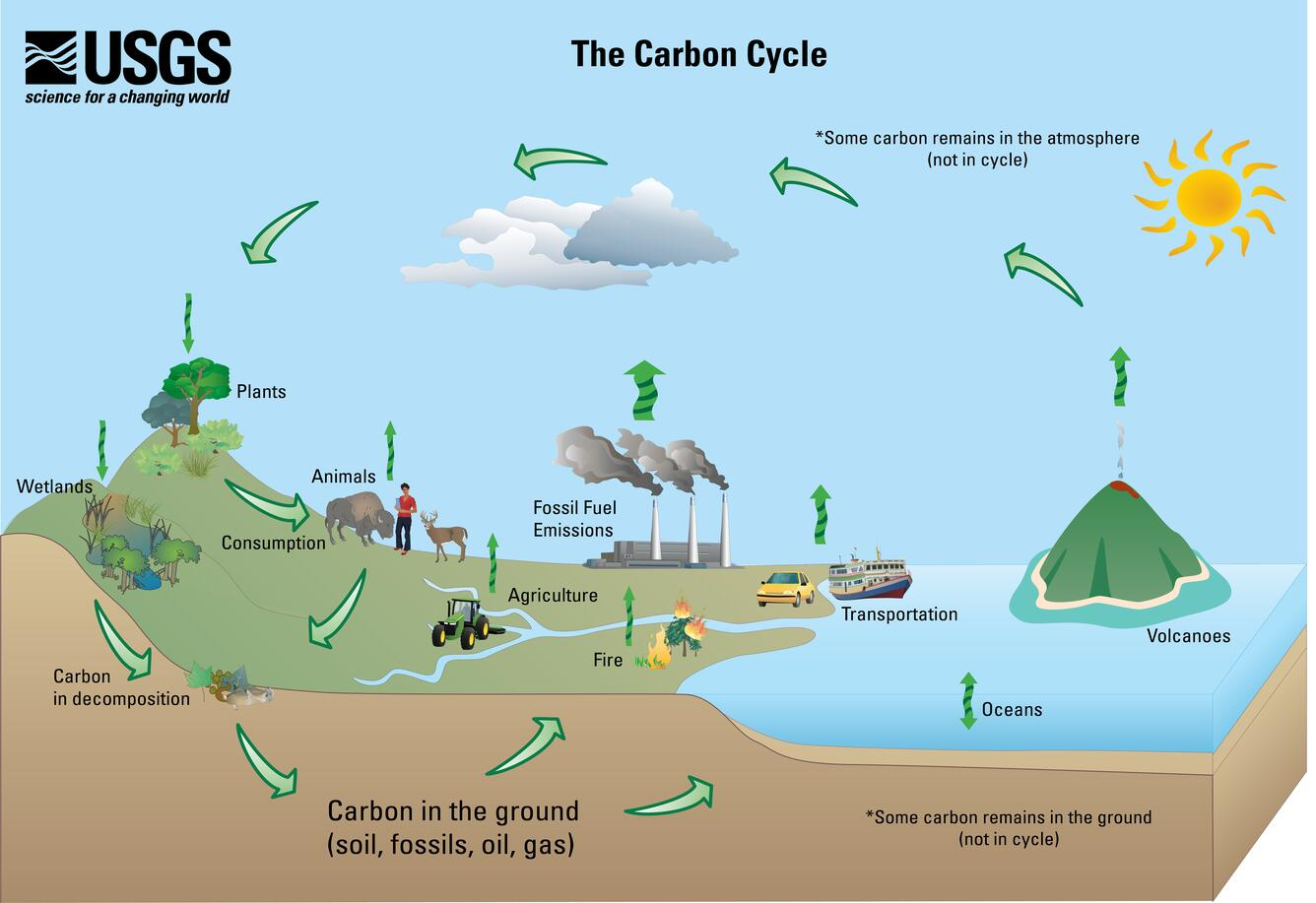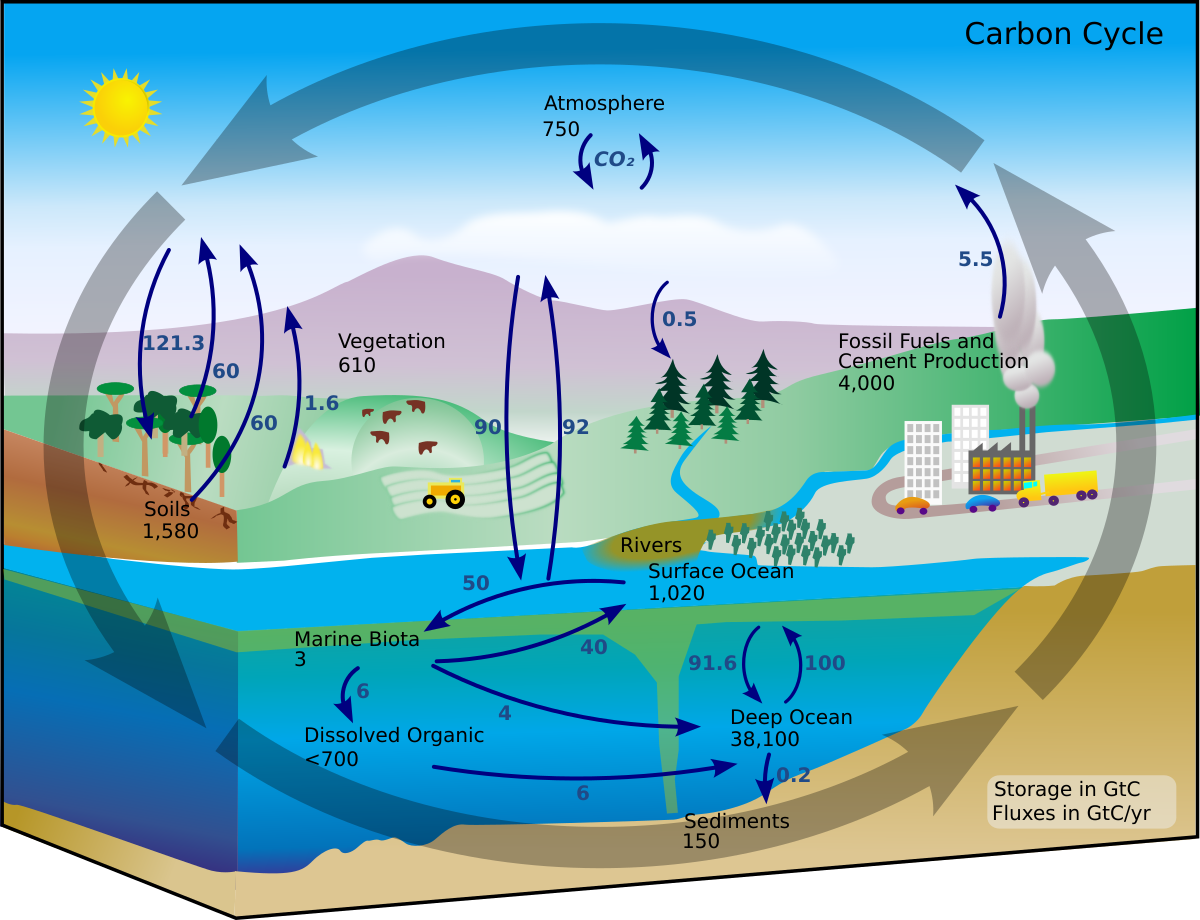IB Syllabus focus:
‘Carbon occurs in organic (biomass, fossil fuels) and inorganic pools (atmosphere, soils, oceans). Residence time varies. Flows include photosynthesis, feeding, respiration, death, decomposition; diagram transfers vs transformations.’
Carbon cycling underpins life and climate regulation. Understanding stores, residence times, and flows of carbon is crucial for explaining how ecosystems function and respond to human disruption.
Carbon Stores
Organic Carbon Pools
Organic stores are those containing carbon in living or once-living organisms. They include:
Biomass (forests, grasslands, plankton, animals) where carbon is held in tissues.
Detritus and organic matter in soils, including dead plants and animals.
Fossil fuels (coal, oil, natural gas) representing ancient carbon stored for millions of years.
Biomass: The total mass of living organisms within a given area or ecosystem, usually expressed in dry weight.
Inorganic Carbon Pools
Inorganic stores exist outside of living systems and include:
Atmosphere (carbon dioxide and methane gases).
Soils containing carbonates and bicarbonates.
Oceans, the largest active carbon store, holding carbon in dissolved forms (CO₂, carbonates, bicarbonates).
Sedimentary rocks (limestone, dolomite) which are vast long-term carbon stores.

Conceptual diagram of the carbon cycle linking atmosphere, biosphere (plants, animals, decomposition), hydrosphere (oceans), and geosphere (carbon in the ground), with arrows indicating flows such as photosynthesis, respiration, and combustion. Labels keep the focus on processes and stores rather than values, matching the syllabus level. Extra elements (e.g., transportation and volcanism) illustrate human and geological sources of CO₂. Source. https://www.usgs.gov/media/images/usgs-carbon-cycle
Residence Time of Carbon
Residence time is the average length of time carbon remains in a store before moving to another. It varies significantly between pools:
Atmosphere: Short-term; carbon dioxide can exchange with oceans or be taken up by plants within days to years.
Biomass: Medium-term; plants and animals hold carbon for years to centuries.
Soils: Decades to centuries, depending on decomposition rates and stability of organic matter.
Oceans: Ranges from days (surface water exchange with atmosphere) to thousands of years (deep ocean storage).
Fossil fuels and rocks: Long-term stores with residence times of millions of years unless disturbed by human activity or geological processes.
Residence Time: The average time a molecule of carbon spends in a given store before being transferred to another.
Residence time is important for evaluating how quickly ecosystems and the climate can respond to change. Short-term stores, like the atmosphere, are highly dynamic, while long-term stores provide relative stability.
Carbon Flows
Flows describe movements of carbon between stores, often involving biological, chemical, or physical processes. These can be divided into transfers and transformations.

Simplified global carbon cycle showing major stores (white numbers, gigatons of carbon) and flows (blue numbers, gigatons of carbon per year) among atmosphere, oceans, land biota, soils, and reactive sediments. Red annotation highlights anthropogenic additions and perturbations to the natural cycle. This figure directly supports the syllabus focus on distinguishing reservoirs from transfers/transformations. Source.
Key Transfers
Transfers are physical movements of carbon without chemical alteration:
Feeding: Carbon moves from plants to herbivores, and then to carnivores.
Death: Carbon in organisms enters detritus pools.
Sedimentation: Dead marine organisms sink and contribute to ocean floor deposits.
Key Transformations
Transformations involve chemical or biological changes to carbon:
Photosynthesis: Plants absorb CO₂ and convert it into glucose and biomass.
Respiration: Organisms release CO₂ back into the atmosphere or water through metabolic processes.
Decomposition: Microbes break down organic matter, releasing carbon as CO₂ or methane.
Combustion: Burning biomass or fossil fuels transforms organic carbon into CO₂.
Photosynthesis: 6CO₂ + 6H₂O → C₆H₁₂O₆ + 6O₂
CO₂ = Carbon dioxide (gas, atmospheric input)
H₂O = Water (reactant, environmental input)
C₆H₁₂O₆ = Glucose (organic carbon product, biomass)
O₂ = Oxygen (by-product released into atmosphere)
Dynamic Balance of Carbon
Fast vs Slow Flows
Fast carbon cycle: Involves atmosphere, biomass, and surface oceans, operating on timescales of days to centuries.
Slow carbon cycle: Involves sedimentary rocks, fossil fuels, and deep oceans, operating on millennial or longer timescales.
Importance of Balance
The carbon cycle is normally balanced when inflows and outflows between stores are relatively equal. Human activities such as fossil fuel combustion and deforestation disrupt this balance, shifting carbon rapidly from long-term stores into the atmosphere.
Interpreting Carbon Diagrams
Students are expected to distinguish between transfers (movements without chemical change) and transformations (movements involving chemical change). Examples:
Transfer: Movement of carbon from dead leaves into soil.
Transformation: Microbial decomposition of soil organic matter into CO₂.
Visual models (such as flow diagrams) are essential for representing the complexity of carbon cycling in ecosystems.
Key Points for IB ESS Students
Carbon exists in both organic and inorganic pools.
Residence time varies greatly, from days in the atmosphere to millions of years in rocks.
Flows are divided into transfers (movement) and transformations (chemical/biological changes).
Human impacts, though not the main focus here, are significant in altering natural residence times and flows, especially by accelerating the release of carbon from long-term stores.
FAQ
Residence time depends on the store’s stability and processes affecting it. For example, fast turnover occurs in the atmosphere due to photosynthesis and respiration. In contrast, sedimentary rock stores remain stable for millions of years because geological processes are slow. Human activity, such as burning fossil fuels, can shorten the residence time of long-term stores.
Surface oceans exchange carbon rapidly with the atmosphere through absorption and outgassing, giving short residence times of days to years. Deep ocean waters, however, act as long-term sinks where carbon may remain for centuries or even millennia, only resurfacing through upwelling or circulation patterns. This distinction makes oceans both fast and slow components of the carbon cycle.
Fossil fuels form over millions of years from compressed organic matter. Their carbon remains locked away unless disturbed.
Natural release is extremely slow, often via volcanism or geological changes.
Human combustion dramatically accelerates release, shifting carbon from a store with a very long residence time into the short-term atmospheric store.
Transfers move carbon physically without changing its form, e.g., herbivores feeding on plants or organic matter being buried in soils.
Transformations alter carbon chemically or biologically, e.g., photosynthesis converting CO₂ into glucose, or combustion turning biomass into atmospheric CO₂.
This distinction helps to separate passive movements from active changes in chemical state.
Decomposition releases carbon from dead organisms into soils and the atmosphere.
Microbial activity breaks down organic compounds, creating CO₂ or methane.
Part of the material may remain as soil organic matter, contributing to medium-term storage.
Thus, decomposition both reduces biomass stores and drives flows into soil and atmospheric pools.
Practice Questions
Question 1 (2 marks)
Define the term residence time in the context of the carbon cycle, and give one example of a carbon store with a short residence time.
Mark scheme:
1 mark for correct definition: Residence time is the average time a molecule of carbon spends in a store before being transferred to another.
1 mark for appropriate example: e.g., atmosphere (days to years), surface ocean (days to years), or vegetation biomass (years to decades).
Question 2 (5 marks)
Explain how carbon flows between the atmosphere, biomass, and soils, distinguishing between transfers and transformations.
Mark scheme:
1 mark for identifying a relevant transfer (e.g., feeding, movement of dead matter to soil).
1 mark for identifying a relevant transformation (e.g., photosynthesis, respiration, decomposition).
1 mark for describing the role of photosynthesis in moving CO₂ into biomass.
1 mark for describing respiration or decomposition in returning carbon to the atmosphere or soil.
1 mark for clearly distinguishing that transfers involve movement without chemical change, while transformations involve chemical/biological change.

